MONGOL LIFE IN CHINA
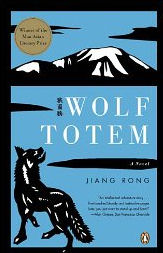
The Mongols have traditionally lived in a variety of dwellings: gers (yurts, tents with a wooden latticework frame), permanent dwelling made from adobe brick, and multistory apartment complexes. Because of the fierce north winds, dwellings face the southeast. The Chinese character “bao" is a transliteration of the Manchu language meaning home and house. In the Mongol and Manchu languages “ger" can mean a yurt, house, shed, shelter, and home. “Ordo" means official tent, palace, government office, and official residence. In agricultural areas of Inner Mongolia, Mongols often live in one-story houses like the Chinese. Those in towns and cities have largely adopted the Chinese way of life. Horseback riding, traditional Mongol mode of transportation, has been replaced by motorcycles, cars and public transport. [Source: William Jankowiak and John Beierle, e Human Relations Area Files (eHRAF) World Cultures, Yale University, National Palace Museum, Taipei]
Gers are rarely used to live in in Inner Mongolia anymore. The majority of rural pastoral households have access to a permanent house. As of 2000, around 70 percent of the territory of Inner Mongolia was still used for pastoralism. However, the majority of Mongols at that time were farmers. Rural districts in Inner Mongolia can be classified into three types: 1) Pastoral districts, with a significant population of mobile pastoralists (Hulun Buir, northern Shilingol and Alasah, parts of Ih Juu, Bayan Nuur, and Ulaanchab leagues; 2) semi-pastoral-semi-sedentary Mongolian populations that practice farming and herding; and 3) agricultural districts where most Han Chinese live.
Now most Mongols in China live in urban areas. To meet the growing demands for labor, especially in industry, the Chinese government has encouraged nationwide rural-to-urban migration as this has been true in Inner Mongolia. The movement has resulted in rapid population growth in the region's larger cities and the arrival of large number of outsiders. largest cities in Inner Mongolia are Baotou (2.7 million in 2020), Hohhot (Huhhot) (2.9 million in 2012), Chifeng (1.2 million in 2020) and Ordos (2 million in 2014). The 2001 population figures were Baotou — 1,146,500; Hohhot — 817,500; Chifeng — 479,300; Wuhai — 343,800; and Tongliao — 324,300..
According to the “Worldmark Encyclopedia of Cultures and Daily Life,” Some Mongols in China “have a special custom called “to meet the firewood-cutter." When it is about time for someone to return home after cutting firewood for a whole day, one member of the family will go ahead to meet the tired person halfway. In this manner they express loving care for the family member engaged in hard labor. [Source: C. Le Blanc, “Worldmark Encyclopedia of Cultures and Daily Life,” Cengage Learning, 2009]
Health risks associated with herding include chronic cold stress, accidental injury, and death from hypothermia. Farmers living on the Hetao Plain, between the Yellow River and the Insham Mountains, suffer from arsenic-related illness. The region has seen a drop in population as entire villages have been abandoned.
See Separate Articles: MONGOLIAN CUSTOMS AND CHARACTER factsanddetails.com : GERS (YURTS): STEPPE HORSEMAN TENTS factsanddetails.com ; LIFE IN A GER (YURT) factsanddetails.com ; GERS IN MONGOLIA factsanddetails.com ; GER LIFE IN MONGOLIA factsanddetails.com ; MONGOL LIFE: CUSTOMS, MEN AND WOMEN factsanddetails.com
RECOMMENDED BOOKS: “The Mongols: A History” by Jeremiah Curtin Amazon.com; “Plateau Women in Transition: The Mongolians” by Deng Qiyao Amazon.com; “The Land of the Camel: Tents and Temples of Inner Mongolia” by Schuyler Cammann (1951) Amazon.com; “Ordos: Stillborn City” by Adrien Golinelli, Christian Caujolle, et al.(2016) Amazon.com; “China's Mongols at University” by Zhenzhou Zhao and Wing On Lee Amazon.com; Culture: “Mongolian Buddhist Culture in China” By Jia Mu Yang . Kai Chao Amazon.com; “Mongolian Sound Worlds” by Jennifer C. Post, Sunmin Yoon, Charlotte D'Evelyn ; “Overtone Singing: Harmonic Dimensions of the Human Voice” by Mark Van Tongeren and Tran Quang Hai Amazon.com; Inner Mongolian Dance - The Heritage of Chinese Culture and Dance (Video) Amazon.com; “Encyclopedia of Chinese Traditional Furniture, Vol. 2: Ethnical Minorities” by Fuchang Zhang Amazon.com; “The Art of Silver Jewellery: From the Minorities of China, The Golden Triangle, Mongolia and Tibet” by René Van Der Star Amazon.com Herders: “Wolf Totem” by Jiang Rong (Novel) Amazon.com; “Wolf Totem” (Film) Amazon.com; “China's Last Nomads: History and Culture of China's Kazaks” by Linda Benson and Ingvar Svanberg Amazon.com; “Winter Pasture: One Woman's Journey with China's Kazakh Herders” by Li Juan, Nancy Wu, et al. Amazon.com; “Exile from the Grasslands: Tibetan Herders and Chinese Development Projects” by Jarmila Ptáčková Amazon.com
Mongolian Society and Political Organization in China
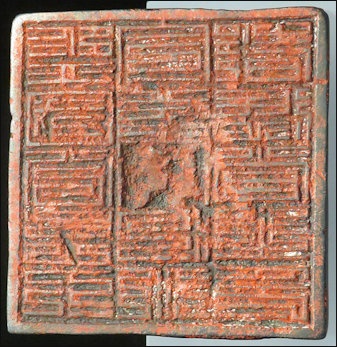
Yuan Dynasty seal
According to the e Human Relations Area Files: “Traditionally, Mongolian society was organized around lay and ecclesiastical social classes. The introduction of market incentives in Inner Mongolia in China countryside reduced the influence of minor officials, but did not undermine the power of the high-ranking officials.
In China, the weakened local government has largely rescinded responsibility for pastoral management to individual households, which makes it difficult to implement coordinated practices. In 1990, Shilingo league instituted a formal group called the HOT that was used to allocate grazing land. These changes have made kinship relations more economically vital than they were in the past, when members of the collective (negdel ) functioned as wage laborers. Today, pastoral households rely upon developed exchange networks (e.g., friends and kin) to supply goods and services. [Source: William Jankowiak and John Beierle, e Human Relations Area Files (eHRAF) World Cultures, Yale University]
In 1947, the Communists established Inner Mongolia in China and continued the Manchu organized banner administrative system. Each banner has its own administrative center, with a population of between 10,000 to 100,000 people. The banner is subdivided into several subdistricts that have several thousand inhabitants. There are twelve perfecture-level units, including nine prefecture-level cities (e.g., Hohhot, Baotou, Wuhai, Chifeng, Tongliao, Ordos, Hulunbuir, Baynnur, and Ulaan Chab) and three leagues (e.g., Xilin Gol, Alxa, Xing'an). There are 101 County-level divisions and 1431 township-level divisions. Prefecture-level cities also include sizable rural areas.
Mongols codified their legal system in the thirteenth century. The Mongol legal code included categories ranging from religious to criminal law. These codes lasted until the Communist Party came to power in 1949. The legal codes stressed collective over individual rights. Everyday affairs were regulated primarily by shame and social censure. Besides the legal code, the state relies on a vast network of police surveillance and informants that provide information on anything that may be considered as a threat to the state.
See Separate Articles: MONGOLIAN SOCIETY factsanddetails.com
Mongol Families and Marriage in China
Historically, the main kinship groups are the nuclear and extended family and the patronymic group (a group of related men, descended from the father's or male side, with their wives and children). A Mongol family usually consists of the parents and their children. When the son gets married he usually lives in a separate home close to his parents. There are also families formed of several married brothers and sisters-in-law in the farming and semi-farming areas.
In farming villages, inheritance practices follow Han Chinese customs. This means that property is given to surviving sons. Urban Mongols tend to follow the Han Chinese inheritance practices which means property is divided equally among offspring.[Source: William Jankowiak, Ian Skoggard, and John Beierle, e Human Relations Area Files (eHRAF) World Cultures, Yale University]
According to Chinatravel.com: Marriage among China's Mongol ethnic minority is a matter of strategic planning and careful deliberation, not something to be entered into hastily. When the young couple are of appropriate age, the young man will ask a respected person - usually his father, an uncle, or other relative - to intercede on his behalf, asking the young woman if she is willing to marry him. However, young, eligible women do not give in easily, as there are many factors to be considered. [Source: Chinatravel.com \=/]
See Separate Articles: WOMEN, FAMILIES AND GENDER ROLES IN MONGOLIA factsanddetails.com ; MARRIAGE AND WEDDINGS IN MONGOLIA factsanddetails.com ; CHILDREN IN MONGOLIA factsanddetails.com ; MONGOL LIFE: CUSTOMS, MEN AND WOMEN factsanddetails.com
Mongol Language Education
According to e Human Relations Area Files: Most Mongols at least attend primary school. Very few pastoral Mongols attend college. In the reform era, herding parents stopped sending their children to elementary schools that used the Mongolian language. Instead they prefer that their children go to schools that offered instruction in Mandarin. Because pastoralists no longer consider herding an economically viable occupation, they prefer their children to seek an alternative livelihood in the towns and cities to accomplish this, they need to speak Mandarin. [Source: William Jankowiak, Ian Skoggard, and John Beierle, e Human Relations Area Files(eHRAF) World Cultures, Yale University]
In cities there is a greater reluctance to send a child to Mongol-only language school, as learning Mandarin and English is considered more suitable for being accepted into a university. For most Mongolian parents, their dilemma arises from the fact that Mongolian language is a symbol of Mongol identity and cultural independence.
There are more than a dozen universities and colleges, more than 80 technical schools, about 5,000 middle (junior and senior) schools, and 30,000 primary schools in Inner Mongolia. The cultural and educational level of the Mongols is higher than average among the national minorities of China. [Source: C. Le Blanc, “Worldmark Encyclopedia of Cultures and Daily Life,” Cengage Learning, 2009]
In northern Inner Mongolia, near the country of Mongolia, there have traditionally been a fair number of schools that carried out a large portion of their instruction in the Mongolian language rather than Mandarin Chinese. In 2020 rules were changed to require these schools to teach more classes and subjects in Mandarin.
See Chinese Replacing the Mongolian Language in Inner Mongolia Schools and Protests Under MONGOL ISSUES, ANGER, ACTIVISM AND PROTESTS IN CHINA factsanddetails.com
Literature of Mongolians in China
The novel "Wolf Totem" has been one of the best selling books in China in recent years and won the Man Asian Literature Prize. Written by Jiang Ring, a former Red Guard who spent much of the 1970s in Inner Mongolia, it is about a man much like the author who is sent to Inner Mongolia to teach the herdsmen there. During his stay he is the one who receives an education — about life on the steppe, especially wolves who are despised for killing the herdsmen’s animals but are revered. Central episodes include adoption of a wolf cub by the main character and a ferocious battle between a starving wolf pack and a herd of wild horses. The book has also recently been translated into English by Howard Goldblatt.
The Gesar epic tradition was inscribed in 2009 on the UNESCO Representative List of the Intangible Cultural Heritage of Humanity. According to UNESCO: The ethnic Tibetan, Mongolian and Tu communities in western and northern China share the story of the ancient hero King Gesar, sent to heaven to vanquish monsters, depose the powerful, and aid the weak while unifying disparate tribes. The singers and storytellers who preserve the Gesar epic tradition perform episodes of the vast oral narrative (known as ‘beads on a string’) in alternating passages of prose and verse with numerous regional differences. [Source: UNESCO]
See KING GESAR: TIBET’S GREAT HEROIC EPIC factsanddetails.com ; See Wolf Totem Under POPULAR AND ACCLAIMED BOOKS IN CHINA: factsanddetails.com
Mongol Art in China
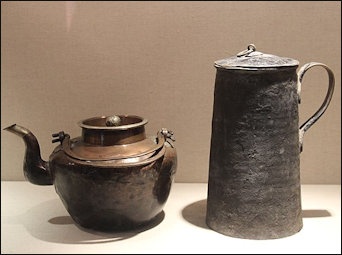
Clothes and jewelry contain some of the finest examples of Mongol art. A Mongol “Headdress Adorned with Coral Beadwork and Turquoise” is on display at the Shanghai Museum. According to the museum: Mongolian costume mainly consists of jewelry, robes, belts and boots, all with bright and rich colors. The costumes vary with different regions and tribal clans and with women’s headgear boasting greatest differences. Mongolian women's headgear is very particular. A set of headgear was often worth many horses or hundreds of camels according to records. [Source: Shanghai Museum]
This set of head ornaments inlaid with silver and coral is the best of all the clans. It belongs to the Ordos type, featuring large size, heavy weight, sophisticated decoration and exquisite workmanship. Made from silver inlaid coral and turquoise and other precious materials, this work looks colorful and eye-catching. Ordos head-ornaments are the most complicated and expensive ones among Mongolian tribes and are the symbol of wealth and social status.
The Inner Mongolia Autonomous Region has film studio. Cultural centers and libraries promote the Mongolian language and cultural productions in cities, towns, and even in the pastoral areas. Pig Cage is a Mongol punk band. The Mongolian singer Daiqing Tana is the the Beijing-based group Haya Band
MONGOLIAN CULTURE, ARTS AND LITERATURE factsanddetails.com ; MONGOLIAN CLOTHES factsanddetails.com ; TRADITIONAL MONGOL MUSIC factsanddetails.com ; KHOOMI SINGERING: SINGING TWO TONES SIMULTANIOUSLY factsanddetails.com ; MONGOL POP MUSIC AND DANCE factsanddetails.com
Mongolian Contributions to Chinese Culture and Science
The Mongolians have a fine cultural tradition, and they have made indelible contributions to China in culture and science. They created their script in the 13th century and later produced many outstanding historical and literary works, including the Inside History of Mongolia of the Mid-13th Century and the History of the Song Dynasty, History of the Liao Dynasty and History of the Kin Dynasty edited by Tuo Tuo, a Mongolian historian during the Yuan Dynasty. The reign also enjoyed a galaxy of Mongolian calligraphers and authors like Quji Wosier who was credited with many works and translations done in the Han and Tibetan languages. Da Yuan Yi Tong Zhi (China's Unification under the Great Yuan Dynasty) was a famous work of geographical studies compiled under the auspices of the Yuan court. Mongolian architecture in the construction of cities and especially of palaces at that time was also unique. [Source: China.org |]
Further advances in culture were made by Mongolians in the Ming Dynasty. Apart from such great literary and historical works as the Golden History of Mongolia, An Outline of the Golden History of Mongolia and Stories of Heir Apparent Wubashehong, Mongolian scholars produced many grammar books and dictionaries, as well as translations of the Inside History of Mongolia and the Buddhist Scripture Kanjur done into Chinese. These works enriched Mongolian culture and promoted cultural exchanges between the Mongolian, Han and Tibetan people. |
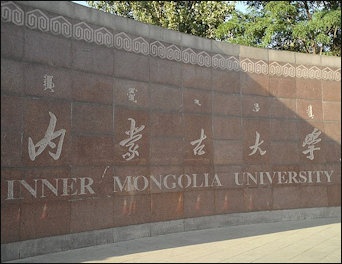
The development of Mongolian culture in the subsequent Qing Dynasty was represented by a greater number of dictionaries and reference books like the Principles of Mongolian, A Collection of Mongolian Words and Phrases, Exegesis of Mongolian Words, Mongolian-Tuote Dictionary, Mongolian-Tibetan Dictionary, Manchurian-Mongolian-Han-Tibetan Dictionary, Manchurian-Mongolian-Han-Tibetan-Uygur Dictionary, Manchurian-Mongolian-Han Tibetan-Uygur-Tuote Dictionary and A Concise Dictionary of Manchurian, Mongolian and Han. Noted literary and historical works included The Origin and Growth of Mongolia, Peace and Prosperity Under the Great Yuan Dynasty, Random Notes from the West Studio, Miscellanies from Fengcheng, A Guide to a Means of Life, A One-storied House, and Weeping Scarlet Pavilion. The Stories of Shageder, also produced in this period, has been regarded as the most outstanding work in the treasure-house of Mongolian literature. Other great works of folk literature include the Story of Gessar Khan of the 11th century, the Life Story of Jianggar, an epic of the 15th century. |
Mongolians owed their achievements in medical science, astronomy and calendar to the influence of the Hans and Tibetans. Mongolian medicine has been best known for its Lamaist therapy, which is most effective for traumatic surgery and the setting of fractured bones. To further develop their medical science, the Mongolians have translated into Mongolian many Han and Tibetan medical works, which include Mongolian-Tibetan Medicine, A Compendium of Medical Science, The of Secret of Pulse Taking, Basic Theories on Medical Science in Four Volumes, Pharmaceutics and Five Canons of Pharmacology. Outstanding contributions have also been made by the Mongolians in the veterinary science. In the field of mathematics and calendar, credit should be given to the Mongolian astronomer and mathematician Ming Antu. During the decades of his service in the Imperial Observatory, he participated in compiling and editing the Origin and Development of Calendar, Sequel to a Study of Universal Phenomena and A Study of the Armillary Sphere. His work Quick Method for Determining Segment Areas and Evaluation of the Ratio of the Circumference of a Circle to Its Diameter (completed by his son and students) is also a contribution to China's development in mathematics. He also made a name for himself in cartography. It was due to his geographical surveys in Xinjiang that the Complete Atlas of the Empire, the first atlas of China drawn with scientific methods, was finished. |
Mongolian Doctors and the Mongolian Medicine
In the course of surviving in a harsh environment and battling illness for centuries, Mongolians have accumulated many unique theories on medicine and treatments, often incorporating local plants, minerals and animals. As early as 13th century, the Mongols were utilizing many medicines and therapies which suited their lifestyle, geography and climate. These included strong “hedier” medicine, moxibustion, bath treatments, bonesetting, traumatism treatment, koumiss treatment, diet treatment, smoke fomentation, cows and sheep's rumen ruminating fomentation and hot blood soak treatment. Their moxibustion and fomentation techniques influenced medical practices in China and Tibet. [Source: Liu Jun, Museum of Nationalities, Central University for Nationalities, Science of China ~]
After the 13th century, as the economic and cultural communication between The Mongols and other Arabs, Europeans and other nationalities increased, non-Mongolian medicines and treatments spread into the Mongolian area, which enriched and developed their knowledge in medical treatment and medicament. In Ming and Qing dynasty, the Mongolian medicine absorbed the theories and clinical experiences of the Tibetan and Chinese medicine. The result were ideas such as Yin and Yang doctrine, five elements doctrine, chills and fever is a unity of opposites doctrine, seven element and three dirt doctrine, six cause dialectical doctrine, internal organs and main and collateral channels doctrine.
Famous Mongolian doctors and health experts have included Naoerji Moergen, Zhanbula, Yixibalazhuer, Zhanbuladaoerji and Yourigedandaer and so on. Among the dozens of famous medical works are the Sea of Prescribes, Four Amrita, the Formal Dictionary of Mongolian Medicine, the Brook of Amrita, An Outline of Examining Pulses, New White Dew Treatment, and Selections from Mongolian Medicine. In the Formal Dictionary of Mongolian Medicine, 879 kinds of medicine were described with 576 illustrations. Over time, the division of departments in clinic practice have became more and more detailed, with department for orthopedics, internal medicine, epidemic, infectious disease, gynecology and obstetrics, pediatrics, dermatology and facial features.
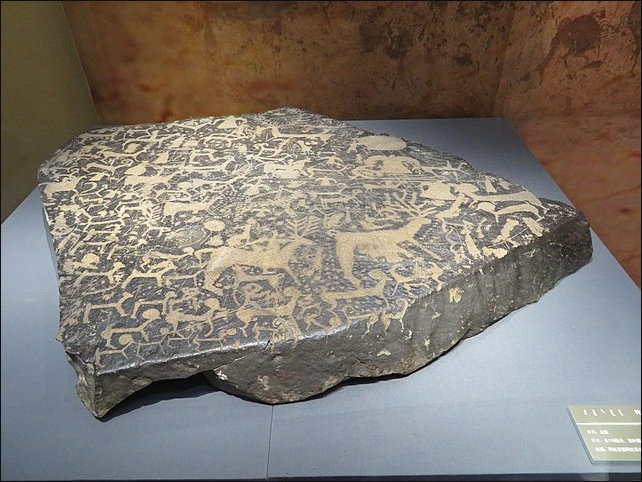
petroglyphs in Inner Mongolia
After PRC was founded in 1949, the health care improved in Inner Mongolian treatment as and medical industry has developed greatly. Dozens of Mongolian hospitals, Chinese Mongolian hospitals, Mongolian medicine research centers and Mongolian medicine colleges have been built in Inner Mongolian Autonomous Region. The Mongolian medical treatment institution and several Mongolian medicine pharmaceutical factories produce over 350 kinds of Mongolian preparation and patent medicine.
Loss and Rebirth of Traditional Mongol Culture in China
While standards of living have risen more ethnic Mongols now seem to be questioning the system under which they live. Christopher Bodeen of Associated Press wrote, “A mining boom has enriched some but pushed further to the margins an already dwindling number of herders — whose roaming the grasslands with their herds of cattle, goats and sheep lies at the core of Mongol identity. Meanwhile a new generation of Mongol students is coming of age wired to the Internet in a time of relative affluence and are questioning what it means to be Mongol.”[Source: Christopher Bodeen, Associated Press, May 31, 2011]
Christopher P. Atwood, an expert on Inner Mongolia who has studied the disintegration of herding communities, told the New York Times that ecological migration was merely accelerating the inevitable demographic shift brought on by two decades of sagging livestock prices and the rural stagnation that drove young Mongolians to the region’s Han-dominated urban centers.”Rural communities are the stronghold of Mongolian culture and language, so breaking them up has a direct impact on ethnic identity,” said Mr. Atwood, chairman of Central Eurasian Studies at Indiana University, Bloomington. [Source: Andrew Jacobs, New York Times, June 11, 2011]
Andrew Jacobs wrote in New York Times, “The result has been a steady decline in the proportion of students who attend Mongolian-language schools, a figure that has dropped by nearly half, to 40 percent, since the 1980s. The shift has largely been propelled by former herders like Huang Liying, 38, a shop owner whose 13-year-old daughter studies at a Mandarin-language school in Baotou, an industrial city 500 miles away.” “To be successful in the modern world you need to speak good Chinese,” Ms. Huang said. “I feel regret she doesn’t speak her mother tongue, but Mongolian is not very useful beyond the grassland.”
Jacobs wrote: “Even if the government is not directly responsible for the ebb of Mongolian language and culture, many of those who joined" anti-government protests have "directed their ire at the Han officials who run the show in Inner Mongolia. They complained about increasing intermarriage, the heavy-handed censorship of local Web sites and the fact that Mongolian script on street signs is sometimes rendered smaller than the adjacent Chinese characters.”
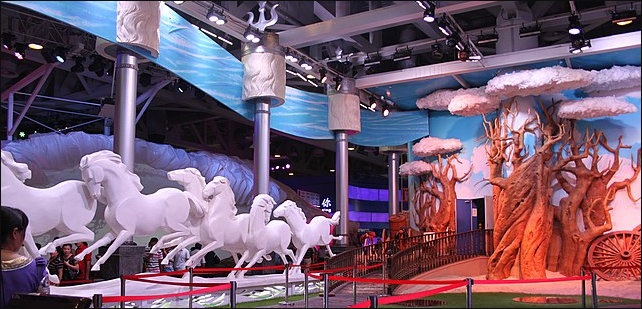
Barry Sautman of Hong Kong University of Science and Technology said the current protest movement "could serve to reinforce Mongol identity and revive calls for protecting pastoralism as an aspect of the culture," Sautman said. The Mandarin language is increasingly popular among Mongolians for economic reasons. A rappers named Sodmuren who raps in Mongol said: "We're worried about the future of the Mongolian language, because there are fewer and fewer children attending bilingual schools. The danger is that we'll lose our Mongolian identity."
Nadaam and Traditional Mongol Sports in China
Nadaam Fair is a seven day fair held in Inner Mongolia in July or August. Nomads and herdsmen, as well as ordinary settled Mongolians, come from all over Inner Mongolia and set up their yurts on an empty grassland. Some come with oxen carts, some with camels, and some with Toyota Landcrusiers. Tea mixed with camel milk and fermented mare’s milk are prepared and everyone carries on and has a good time. The fairs in Hohhot and Baotou are open to tourists. During the day there are all kinds of competitions: bulu throwing, horse lassoing, Mongolian chess, balls games and martial arts. Mongolian tug of wars are interesting. Two competitors bend over and face away from each other with their butts sticking in the air. A rope is looped around the competitors' waists and they pull. The most popular events are traditional Mongolian wrestling matches, horse racing and archery. At night people sit around bonfires and watch dances and performances and listen to haolabao, a kind of story telling put to song.
Nadaam (meaning "to play" or "have a good time") is the biggest Mongol holiday of the year. It has traditionally been a time when nomads gathered at designated places in the country to enjoy long summer days, catch up on news with old friends and enjoy traditional Mongolian sports. The explorer Roy Chapman Andrews described the Nadaam he saw in 1922 as "an amazing spectacle. "All the elite of Mongolia gather on the Tola [Tula] River, dressed in their most splendid robes," he wrote. "The archery, wrestling, and horse racing are famous throughout the East.”
In China, the content and form of Nadaam changed greatly after the Communist take over 1949. In addition to the three traditional sports game—wrestling, horse racing and archery— the content was enlarged to include many new activities, such as theatrical performances and movies. In some places the festivities last for seven days. According to the Chinese government: “The newly added contents pushed the traditional national grand meeting to a joyous, auspicious, happy and effective one. Nowadays, Nadaam is always held in the golden autumn or summer when the herds of sheep and cattle are thriving. Herdsman converge from all directions carrying yurt and all kinds of meat and milk food on their light wooden cart. While putting up the yurt on the greensward, people begin to simmer tea and stew meat. While Smoke curls upward from kitchen chimneys on the whole grassland, all the people are absorbed in a joyous atmosphere.”
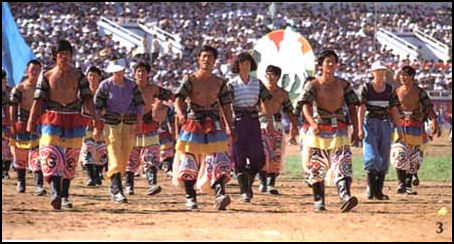
Wrestlers at Mongol festival
In China, the Mongolians of Inner Mongolia have a reputation for being good at sports. According to the Chinese government: “The mass sports activities such as wrestling, horse racing and archery play the very important role in both physical training and enrichment of amateur culture life. The more important thing is that, numbers of excellent athletes are cultivated in Inner Mongolian Autonomous Region and Xinjiang Uyghur Autonomous Region. Mongolian athletes are always the winners in many competitions in the country, as well as some international matches, wining honor for the Chinese nation.”
See Separate Article: NADAAM AND MONGOLIAN HOLIDAYS, FESTIVALS AND TRADITIONAL SPORTS factsanddetails.com
Image Sources:
Text Sources: 1) "Encyclopedia of World Cultures: Russia and Eurasia/ China", edited by Paul Friedrich and Norma Diamond (C.K. Hall & Company; 2) Liu Jun, Museum of Nationalities, Central University for Nationalities, Science of China, China virtual museums, Computer Network Information Center of Chinese Academy of Sciences, kepu.net.cn ~; 3) Ethnic China *\; 4) Chinatravel.com \=/; 5) China.org, the Chinese government news site china.org | New York Times, Washington Post, Los Angeles Times, Times of London, Lonely Planet Guides, Library of Congress, Chinese government, The Guardian, National Geographic, Smithsonian magazine, The New Yorker, Reuters, AP, AFP, Wikipedia, BBC, and various books, websites and other publications.
Last updated October 2022
